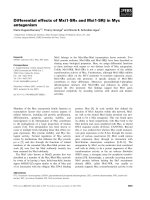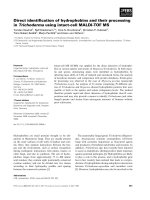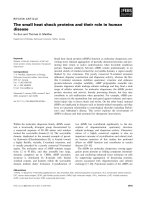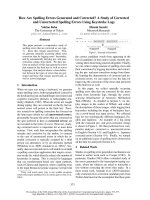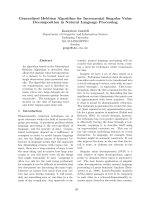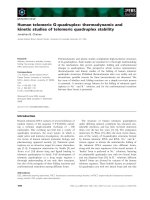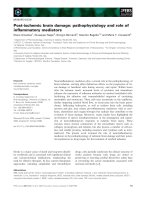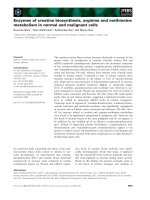Báo cáo khoa học: "Why Are They Excited? Identifying and Explaining Spikes in Blog Mood Levels" potx
Bạn đang xem bản rút gọn của tài liệu. Xem và tải ngay bản đầy đủ của tài liệu tại đây (140.57 KB, 4 trang )
Why Are They Excited?
Identifying and Explaining Spikes in Blog Mood Levels
Krisztian Balog Gilad Mishne Maarten de Rijke
ISLA, University of Amsterdam
Kruislaan 403, 1098 SJ Amsterdam
kbalog,gilad,
Abstract
We describe a method for discovering ir-
regularities in temporal mood patterns ap-
pearing in a large corpus of blog posts,
and labeling them with a natural language
explanation. Simple techniques based
on comparing corpus frequencies, coupled
with large quantities of data, are shown to
be effective for identifying the events un-
derlying changes in global moods.
1 Introduction
Blogs, diary-like web pages containing highly
opinionated personal commentary, are becoming
increasingly popular. This new type of media of-
fers a unique look into people’s reactions and feel-
ings towards current events, for a number of rea-
sons. First, blogs are frequently updated, and like
other forms of diaries are typically closely linked
to ongoing events in the blogger’s life. Second, the
blog contents tend to be unmoderated and subjec-
tive, more so than mainstream media—expressing
opinions, thoughts, and feeling. Finally, the large
amount of blogs enables aggregation of thousands
of opinions expressed every minute; this aggrega-
tion allows abstractions of the data, cleaning out
noise and focusing on the main issues.
Many blog authoring environments allow blog-
gers to tag their entries with highly individual (and
personal) features. Users of LiveJournal, one of
the largest weblog communities, have the option
of reporting their mood at the time of the post;
users can either select a mood from a predefined
list of common moods such as “amused” or “an-
gry,” or enter free-text. A large percentage of Live-
Journal users tag their postings with a mood. This
results in a stream of hundreds of weblog posts
tagged with mood information per minute, from
hundreds of thousands of users across the globe.
The collection of such mood reports from many
bloggers gives an aggregate mood of the blogo-
sphere for each point in time: the popularity of
different moods among bloggers at that time.
In previous work, we introduced a tool for
tracking the aggregate mood of the blogosphere,
and showed how it reflects global events (Mishne
and de Rijke, 2006a). The tool’s output includes
graphs showing the popularity of moods in blog
posts during a given interval; e.g., Figure 1 plots
the mood level for “scared” during a 10 day pe-
riod. While such graphs reflect some expected
patterns (e.g., an increase in “scared” around Hal-
loween in Figure 1), we have also witnessed spikes
and drops for which no associated event was
Figure 1: Blog posts labeled “scared” during the October 26–
November 5, 2005 interval. The dotted (black) curve indi-
cates the absolute number of posts labeled “scared,” while
the solid (red) curve shows the rate of change.
known to us. In this paper, we address this is-
sue: we seek algorithms for identifying unusual
changes in mood levels and explaining the under-
lying reasons for these changes. By “explanation”
we mean a short snippet of text that describes the
event that caused the unusual mood change.
To produce such explanations, we proceed as
follows. If unusual spikes occur in the level of
mood m, we examine the language used in blog
posts labeled with m around and during the pe-
riod in which the spike occurs. We interpret words
207
that are not expected given a long-term language
model for m as signals for the spike in m’s level.
To operationalize the idea of “unexpected words”
for a given mood, we use standard methods for
corpus comparison; once identified, we use the
“unexpected words” to consult a news corpus from
which we retrieve a small text snippet that we then
return as the desired explanation.
In Section 2 we briefly discuss related work.
Then, we detail how we detect spikes in mood lev-
els (in Section 3) and how we generate natural lan-
guage explanations for such spikes (in Section 4).
Experimental results are presented in Section 5,
and in Section 6 we present our conclusions.
2 Related work
As to burstiness phenomena in web data, Klein-
berg (2002) targets email and research papers, try-
ing to identify sharp rises in word frequencies in
document streams. Bursts can be found by search-
ing periods when a given word tends to appear at
unusually short intervals. Kumar et al. (2003) ex-
tend Kleinberg’s algorithm to discover dense pe-
riods of “bursty” intra-community link creation in
the blogspace, while Nanno et al. (2004) extend it
to work on blogs. We use a simple comparison be-
tween long-term and short-term language models
associated with a given mood to identify unusual
word usage patterns.
Recent years have witnessed an increase in re-
search on extracting subjective and other non-
factual aspects of textual content; see (Shanahan et
al., 2005) for an overview. Much work in this area
focuses on recognizing and/or annotating evalu-
ative textual expressions. In contrast, work that
explores mood annotations is relatively scarce.
Mishne (2005) reports on text mining experiments
aimed at automatically tagging blog posts with
moods. Mishne and de Rijke (2006a) lift this work
to the aggregate level, and use natural language
processing and machine learning to estimate ag-
gregate mood levels from the text of blog entries.
3 Detecting spikes
Our first task is to identify spikes in moods re-
ported in blog posts. Many of the moods reported
by LiveJournal users display a cyclic behavior.
There are some obvious moods with a daily cycle.
For instance, people feel awake in the mornings
and tired in the evening (Figure 2). Other moods
show a weekly cycle. For instance, people drink
more at the weekends (Figure 3).
Figure 2: Daily cycles for “awake” and “tired.”
Figure 3: Weekend cycles for “drunk.”
Our idea of detecting spikes tries to deal with
these cyclic events and aims at finding global
changes. Let POSTS (mood, date, hour) be the
number of posts labelled with a given mood and
created within a one-hour interval at the speci-
fied date. Similarly, ALLPOSTS (date, hour) is
the number of all posts created within the interval
specified by the date and hour. The ratio of posts
labeled with a given mood to all posts could be
expressed for all days of a week (Sunday, . . . , Sat-
urday) and for all one-hour intervals (0, . . . , 23)
using the formula:
R(mood, day, hour) =
DW (date)=day
POSTS (mood, date, hour)
DW (date)=day
ALLPOSTS (date, hour)
,
where day = 0, . . . , 6 and DW (date) is a day-of-
the-week function that returns 0, . . . , 6 depending
on the date argument.
The level of a given mood is changed within
a one-hour interval of a day, if the ratio of posts
labelled with that mood to all posts, created within
the interval, is significantly different from the ratio
that has been observed on the same hour of the
similar day of the week. Formally:
D(mood, date, hour) =
P OST S(mood,date,hour)
ALLP OST S(date,hour)
R(mood, DW (date), hour)
.
If |D| (the absolute value of D) exceeds a thresh-
old we conclude that a spike has occurred, while
208
the sign of D makes it possible to distinguish be-
tween positive and negative spikes. The absolute
value of D expresses the degree of the peak.
This method of identifying spikes allows us to
look at a period of a few hours instead of only
one, which is an effective smoothing method, es-
pecially if a sufficient number of posts cannot be
observed for a given mood.
4 Explaining peaks
Our next task is to explain the peaks identified by
the methods listed previously. We proceed in two
steps. First, we discover features in the peaking
interval which display a significantly different lan-
guage usage from that found in the general lan-
guage associated with the mood. Then we form
queries using these “overused” words as well as
the date(s) of the peaking interval and run these as
queries against a news corpus.
4.1 Overused words To discover the reasons
underlying mood changes we use corpus-based
techniques to identify changes in language usage.
We compare two corpora: (1) the full set of blog
posts, referred to as the standard corpus, and (2) a
corpus associated with the peaking interval, re-
ferred to as the sample corpus.
To compare word frequencies across the two
corpora we apply the log-likelihood statistical
test (Dunning, 1993). Let O
i
be the observed
frequency of a term, N
i
its total frequency, and
E
i
= (N
i
·
i
O
i
)/
i
N
i
its expected frequency
in corpus i (where i takes values 1 and 2 for the
standard and sample corpus, respectively). Then,
the log-likelihood value is calculated according to
this formula: −2 ln λ = 2
i
O
i
ln
O
i
E
i
.
4.2 Finding explanations Given the start and
end dates of a peaking interval and a list of
overused words from this period, a query is
formed. This query is then submitted to (head-
lines of) a news corpus. A headline is retrieved if
it contains at least one of the overused words and
is dated within the peaking interval or the day be-
fore the beginning of the peak. The hits are ranked
based on the number of overused terms contained
in the headline.
5 Experiments
In this section we illustrate our methods with some
examples and provide a preliminary analysis of
their effectiveness.
5.1 The blog corpus Our corpus consists of
all public blogs published in LiveJournal during
a 90 day period from July 5 to October 2, 2005,
adding up to a total of 19 million blog posts. For
each entry, the text of the post along with the date
and time are indexed. Posts without an explicit
mood indication (10M) are discarded. We applied
standard preprocessing steps (stopword removal,
stemming) to the text of blog posts.
5.2 The news corpus The collection con-
tains around 1000 news headlines that have
been published in Wikinews (http://www.
wikinews.org) during the period of July-
September, 2005.
5.3 Case studies We present three particular
cases where an irregular behavior in a certain
mood could be observed. We examine how accu-
rately the overused terms describe the events that
caused the spikes.
5.3.1 Harry Potter In July, 2005, a peak in
“excited” was discovered; see Figure 4, where the
shaded (green) area indicates the “peak area.”
Figure 4: Peak in “excited” around July 16, 2005.
Step 1 of our peak explanation method (Sec-
tion 4) reveals the following overused terms dur-
ing the peak period: “potter,” “book,” “excit,”
“hbp,” “read,” “princ,” “midnight.” Step 2 of
our peak explanation method (Section 4) exploits
these words to retrieve the following headline
from the news collection: “July 16. Harry Potter
and the Half-Blood Prince released.”
5.3.2 Hurricane Katrina Our next exam-
ple illustrates the need for careful thresholding
when defining peaks (see Section 3). We show
peaks in “worried” discovered around late Au-
gust, with a 40% and 80% threshold. Clearly, far
more peaks are identified with the lower threshold,
while the peaks identified in the bottom plot (with
the higher threshold), all appear to be clear peaks.
The overused terms during the peak period include
“orlean,” “worri,” “hurrican,” “gas,” “katrina” In
209
Figure 5: Peaks in “worried” around August 29, 2005. (Top:
threshold 40% change; bottom: threshold 80% change)
Step 2 of our explanation method we retrieve the
following news headlines (top 5 shown only):
(Sept 1) Hurricane Katrina: Resources regarding
missing/located people
(Sept 2) Crime in New Orleans sharply increases
after Hurricane Katrina
(Sept 1) Fats Domino missing in the wake of Hur-
ricane Katrina
(Aug 30) At least 55 killed by Hurricane Katrina;
serious flooding across affected region
(Aug 26) Hurricane Katrina strikes Florida, kills
seven
5.3.3 London terror attacks On July 7 a
sharp spike could be observed in the “sad” mood;
see Figure 6; the tone of the shaded area shows the
degree of the peak. Overused terms identified for
this period include “london,” “attack,” “terrorist,”
“bomb,’ “peopl”, “explos.” Consulting our news
Figure 6: Peak in “sad” around July 7, 2005.
corpus produced the following top ranked results:
(July 7) Coordinated terrorist attack hits London
(July 7) British Prime Minister Tony Blair speaks
about London bombings
(July 7) Bomb scare closes main Edinburgh thor-
oughfare
(July 7) France raises security level to red in re-
sponse to London bombings
(July 6) Tanzania accused of supporting terror-
ism to destabilise Burundi
5.4 Failure analysis Evaluation of the meth-
ods described here is non-trivial. We found that
our peak detection method is effective despite its
simplicity. Anecdotal evidence suggests that our
approach to finding explanations underlying un-
usual spikes and drops in mood levels is effective.
We expect that it will break down, however, in case
the underlying cause is not news related but, for in-
stance, related to celebrations or public holidays;
news sources are unlikely to cover these.
6 Conclusions
We described a method for discovering irregulari-
ties in temporal mood patterns appearing in a large
corpus of blog posts, and labeling them with a
natural language explanation. Our method shows
that simple techniques based on comparing corpus
frequencies, coupled with large quantities of data,
are effective for identifying the events underlying
changes in global moods.
Acknowledgments This research was supported
by the Netherlands Organization for Scientific
Research (NWO) under project numbers 016
054.616, 017.001.190, 220-80-001, 264-70-050,
365-20-005, 612.000.106, 612.000.207, 612.013
001, 612.066.302, 612.069.006, 640.001.501, and
640.002.501.
References
T. Dunning. 1993. Accurate methods for the statistics of
surprise and coincidence. Comput. Ling., 19(1):61–74.
J. Kleinberg. 2002. Bursty and hierarchical structure in
streams. In Proc. 8th ACM SIGKDD Intern. Conf. on
Knowledge Discovery and Data Mining, pages 1–25.
R. Kumar, J. Novak, P. Raghavan, and A. Tomkins. 2003. On
the bursty evolution of blogspace. In Proc. 12th Intern.
World Wide Web Conf., pages 568–576.
G. Mishne and M. de Rijke. 2006a. Capturing global mood
levels using blog posts. In AAAI 2006 Spring Symp. on
Computational Approaches to Analysing Weblogs (AAAI-
CAAW 2006). To appear.
G. Mishne and M. de Rijke. 2006b. MoodViews: Tools
for blog mood analysis. In AAAI 2006 Spring Symp. on
Computational Approaches to Analysing Weblogs (AAAI-
CAAW 2006).
G. Mishne. 2005. Experiments with mood classification in
blog posts. In Style2005 – 1st Workshop on Stylistic Anal-
ysis of Text for Information Access, at SIGIR 2005.
T. Nanno, T. Fujiki, Y. Suzuki, and M. Okumura. 2004. Au-
tomatically collecting, monitoring, and mining Japanese
weblogs. In Proc. 13th International World Wide Web
Conf., pages 320–321.
J.G. Shanahan, Y. Qu, and J. Wiebe, editors. 2005. Comput-
ing Attitude and Affect in Text: Theory and Applications.
Springer.
210
